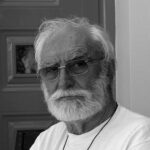“I can only wish that my art will function as a catalyst for a better future of humanity; that it can help drive human energy towards creation, instead of violence and destruction. Like a message in a bottle in the streams of history, I hope and wish that my art can help shape prospects for the survival of humankind and the renewal of civilization.”
Theodoros, sculptor 2018
Messages in the streams of history: A dialogue with sculptor Theodoros by Lydia Papadimitriou & Mark Durden, Journal of Greek Media & Culture, Volume 4, Number 1,2018.

Theodoros (Θόδωρος) was born in Agrinio in 1931. His trajectory in art began when, as a child, he made his own toys with clay, wood, wire and other materials. The advent of WWII, the Occupation and the Greek Civil War left him with profoundly traumatic experiences that later fuelled his work.
Theodoros studied sculpture in Athens in the 1950s and in Paris in the 1960s, where he stayed until 1974, creating the sculptural series Gates and Delphics, and participating in many exhibitions and debates about art. The brutal dominance of the junta in Greece in 1967 deeply affected the course of his work, leading him to deconstruct and expose the communication codes of the artwork (see Manifesto – October 1970 and Manipulations). In the 1970s, he had exhibitions in many countries, including Italy, Belgium, Holland, Portugal, Turkey, South Korea and the United States – where he also taught as a visiting professor. In 1980, he was elected Professor of Plastic Arts at the School of Architecture of the National Technical University in Athens.
Theodoros has also published numerous articles and books, in which he further unravels his approach to art as communication, and sculpture as a diachronic art of public space.
Works by Theodoros are found in various private collections and museums in Greece and abroad such as the National Gallery – Museum of Alexandros Soutsos, the National Museum of Contemporary Art (EMST) in Athens, MOMUS in Thessaloniki and also in public places and buildings such as the Athens Stock Exchange (Rising Index, 2007), at Syntagma station in the Athens metro (The Metro Clock, 2001) and on the facade of the Hellenic Olympic Committee (Olympic Diptych, 1996), the European Cultural Center of Delphi ( Sphinx II ’65, 1999),
After Theodoros death in 2018, a significant amount of his works were inherited by the National Museum of Conteporary Art (EMST) in Athens, while the Interdisciplinary Center for the Study of Sculpture, Architecture and Communication under the name Cities in Balance has undertaken the continuation of his intellectual work, which aims to improve the conditions in the urban space through art, architecture and communication.


